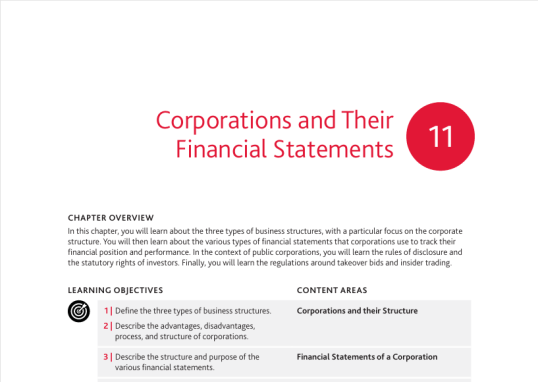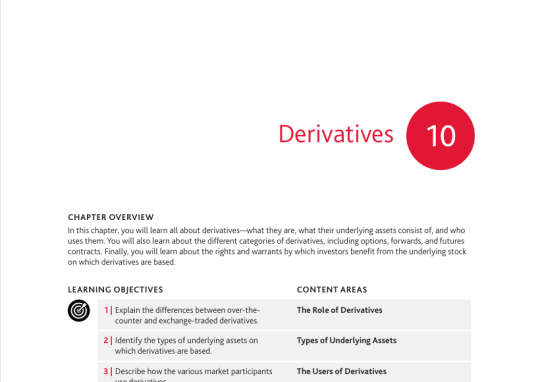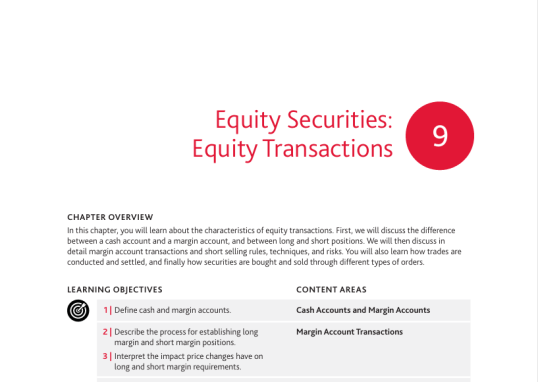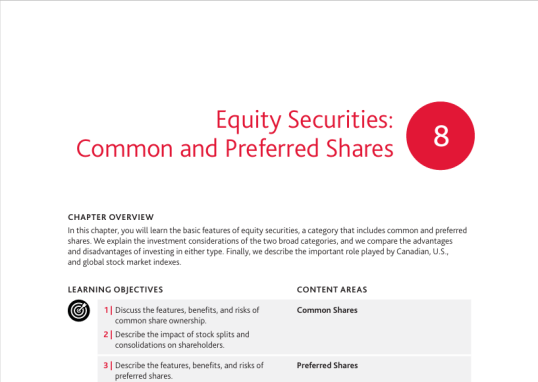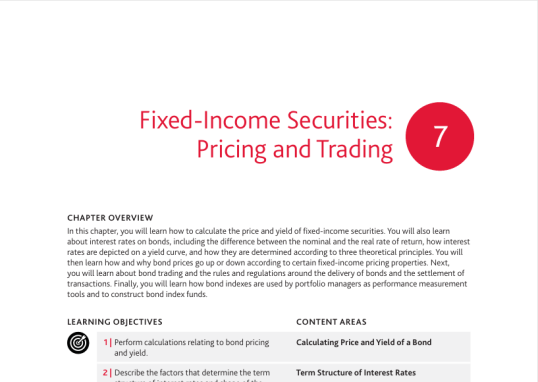CSC V.1 Chapter1 notes
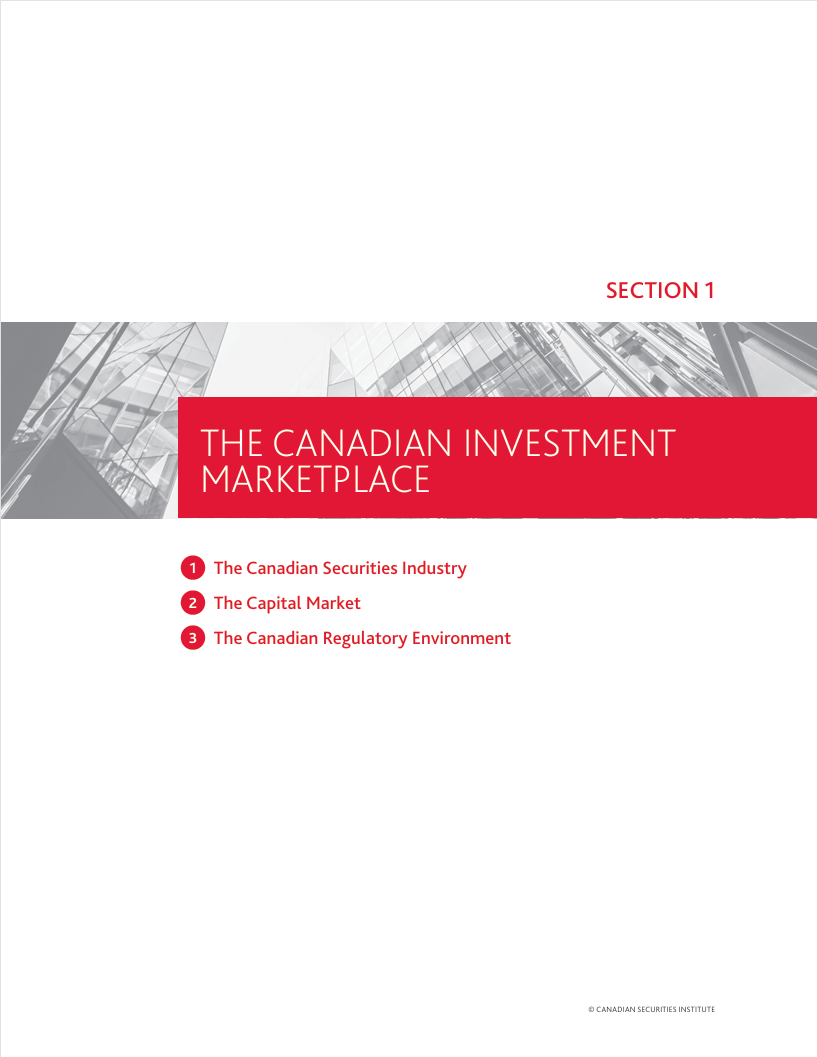
Chapter 1
The Canadian Securities industry
The Canadian securities industry is mainly regulated by the provinces. Who use securities commissions to create and enforce their own laws and regulations.
Securities commissions delegate some power to self regulatory organizations (SRO’s) such as IIROC (Investment industry regulatory Organization of Canada)
Major participants in the industry include:
1. Suppliers of capital (investors)
2. Investment dealers
3. Users of capital (Borrowers/users)
4. Self-regulatory organizations
5. Markets
6. Clearing and settlement
7. Canadian securities institute
8. Canadian investor protection fund
9. Provincial regulators
Financial Intermediary
intermediary – investment dealers, banks, credit unions, trust companies, and insusrance companies.
This term describes any organization that facilitates the trading or movement of financial instruments. Investment dealers act on their clients’ behalf as agents and sometimes act as principals, risking their own capital.
Two main functions: They help to transfer capital from suppliers to users through the underwriting and distribution of new securities (primary market distribution) and maintain secondary markets in which previously issued or outstanding securities can be traded.
Three categories of investment dealers are: Retail firms which include full-service investment dealers and self- directed brokers (discount brokers); Institutional firms that service clients like pension funds and mutual funds; and integrated firms.
Organization Within Firms
There is a three level organization structure: Front office, middle office and back office.
Front office performs all staff functions pertaining directly to portfolio management activities. Functions include: Portfolio management, Trading, Sales, Marketing.
Middle office performs functions critical to the efficient operation of the firm. Functions include: Compliance, Accounting, Audits, Legal.
Back office settles the firm’s security transactions. Functions include Trade settlement.
Principal Versus Agency Functions
Most of the time, securities firms act as agents, buying and selling on behalf of clients without taking title (ownership) to those securities. Broker is a synonym for agent.
Securities firms tend to act as principals in the underwriting function (this is the primary market) and in secondary trading of non-equity securities (fixed income products)… “Generally, for most secondary trading of debt securities, the investment dealer acts as principal…”.
When acting as an agent, an investment dealer does not own the securities. Their profit is the commission they charge for both buying and selling those securities.
Services provided by the investment dealer include: providing informed advice about the terms and features for new issues in the primary market; adding liquidity to the market; acting as market makers in assigned listed stocks; and buying listed stock as principals.
The Clearing System
During the day, an exchange member will buy and sell many different listed stocks. A designated clearing systems handles the daily settlement process between members, which means exchanging securities for cash.
Securities in Canada are cleared through CDS Clearing and Depository Securities. Marketplaces like the TSX and TSX Venture and ATSs report trades to CDSX clearing and settlement. Participants with access to the clearing system include banks, investment dealers and trust companies.
The clearing system reduces the number of securities and amount of cash that has to change hands among the various members each day. The central clearing system uses a process called netting to establish and confirm a credit or debit position.
Banks As Financial Intermediary
Banks operate under the Bank Act, which specifies what they can and cannot do. Banks are the most important player in the Canadian Securities Industry and each Bank is designated as either Schedule I, Schedule II or Schedule III.
- Schedule I Banks: most Canadian owned banks are designated Schedule I. There are ownership rules – voting shares must be widely held and subject to no more than 20% ownership by any individual or group. There are more than 30 Schedule I Banks altogether – including Royal Bank, CIBC, TD, Bank of Nova Scotia, Bank of Montreal and National Bank.
- Schedule II Banks: incorporated and operate in Canada, but are owned by a foreign parent – examples include Citibank Canada, AMEX Bank of Canada and BNP Paribas (Canada). By law, may engage in all types of business permitted to a Schedule I Bank; however most derive their greatest share of revenue from retail banking and electronic financial services.
- Schedule III Banks: foreign bank branches of foreign institutions. Schedule III banks tend to focus on corporate and institutional finance and investment banking.
Other Financial Intermediaries
Credit unions and caisses populaires offer businesses and consumer a wide variety of banking services. Federal rules require these organizations to adhere to a “prudent portfolio approach”.
Trust and loan companies are the only corporations authorized to engage in a trust business.
The insurance industry has two main lines of business: Life insurance and property and casualty insurance. Life
insurance products include: Health and disability insurance; term and whole life insurance; pension plans;
registered retirement savings plans; and annuities. Property and casualty insurance encompasses protection
against: Home; auto; and commercial business. Underwriting is the most important aspect of the insurance business in Canada.
Investment funds sell shares or units to the public and invest the proceeds. Closed-end funds issues shares at start-up or infrequently. Open-end funds or mutual funds continually issue shares.
Alberta Treasury Branches (ATB) are known as savings banks and provide a full range of financial services to Albertans.
Consumer finance companies make direct cash loans to consumers, typically changing higher rates of interest than banks.
Sales finance companies purchase instalment sales contracts from retailers and dealers at a discount when products like new cars or appliances are bought on instalment plans.
Pension plans have accounted for remarkable growth in the institutionalization of savings.
Fincial Market Trends
Financial technology companies, known collectively as fintech take advantage of computer technology to support or enable a variety of banking and financial products and services
Robo-advisors provide clients with goal-based online investment management. Portfolios are created using
algorithms based on modern portfolio theory. Advisor support is offered to varying degrees, typically online or by
phone. Portfolios are built with exchange-traded funds. Portfolios are regularly rebalanced.
Social and economic shifts include demographics (an aging country); defined benefit and defined contribution plans
(defined benefit plans provide pre-determined payment amounts); savings rates (common notion is that Canadians
need 70% of their income at retirement); and household debt (has increased from 100% to disposable income in 2000 to 172% currently).
Cryptoassets have been gaining popularity. These are assets that exist only in digital form and relies on peer-to-peer networking and a public ledger. Bitcoin is the largest and most actively traded cryptocurrency and is powered by blockchain, which creates a shared public ledger. Its value is derived from its use as a medium of exchange and as a store of value.
Author
shanghaizhangyijie@gmail.com

